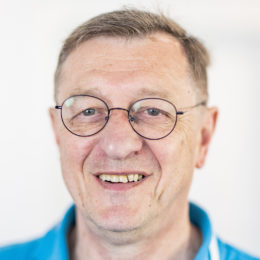The World is three dimensional, but the physical systems living in it can be very long in one dimension and very thin in another one.
Viktor Pergamenshchyk
Then it is both natural and convenient to call such systems one-dimensional or quasi-one dimensional if the thickness’ finite size, even very small, has certain importance. Quantum effects, such as a purely quantum state of matter called Bose-Einstein condensate, are not easy to observe because they appear only at extremely low temperatures close to the absolute zero. Recently, scientists have managed to create ultracold gases where molecules are isolated from the “hot” world in elongated apparently one-dimensional tube-like electromagnetic traps. This has resulted in the discovery of new unexpected effects, of which maybe most striking one is that a gas in such traps breaks into droplets. These are quantum droplets which makes their physics very difficult as quantum theory of many-particle systems is very complex. Molecules have tiny hard cores, but we know for sure that certain interaction between molecules at distances larger than these cores is essential for the droplet states to appear. The problem is that incorporation of such an interaction in quantum many-body problems is a formidable and unresolved task. And here we recall that the droplets have some macroscopically large parameters such as size, form, and the number of particles which, at least partially, can be described classically. Moreover, including an interaction in a quasi-one-dimensional system of classical hard core particles, hard spheres, is possible thanks to the method developed recently by the author. Thus, while to incorporate the intermolecular interaction in the case of an ultracold quantum gas is a formidable problem, it is possible to do so in a classical gas of hard spheres. The idea of the project is to study classical systems of interacting hard spheres in the geometries similar to those into which the electromagnetic traps shape ultracold gases. Moreover, the method mentioned above enables one to describe some of such classical many-body systems analytically without any approximation, i.e., exactly, which is of great importance to the classical statistical physics itself. The reason can be described like that: one phase can replace another one as certain parameter (e.g., temperature) crosses just a single transition point (e.g., 0 Co in case of water-ice transition) and any inaccuracy can substantially change or even remove or incorrectly add such point. The main objective of the proposed project is to analytically study classical quasi-one-dimensional hard sphere systems bearing in mind their possible implications for ultracold quantum gases. The aim of the project is to develop analytically solvable models of interacting classical hard spheres in narrow quasi-one-dimensional channels of different transverse cross-sections, solve these models, and describe possible ordered structures, the phases, possible for different densities and temperatures. We will consider the simplest plane quasi-one-dimensional channel when hard spheres are actually hard disks, and a channel with a square cross-section with and without interaction. The interaction will be only between a sphere and its two next neighbors. At high densities, hard spheres tend to form an arrangement in the form of a crystalline zigzag and its transformation into a liquid, disordered state is the main ordering process. The geometry with the square cross-section offers two equivalent diagonal planes for such a zigzag and the system eventually must spontaneously choose just one. Such spontaneous process is called spontaneous symmetry breaking and is associated with the transformation from a disordered (liquid) into ordered (crystalline zigzag) phase, called phase transition. It is known that phase transitions are not possible in one dimension and it is important to find that it can take place in the described quasi-one-dimensional geometry although the channel remains very thin. The type of this transition will be established. We will especially focus on the dipole-dipole interaction which is known to result in droplet-like structures in the quantum gases near their Bose condensation. We hope the quasi-one-dimensional classical models will help one to clarify the condition for the homogeneous state to break into droplet-like state observed in quantum ultracold gases.
Project details
Project title: Solvable models of quasi-one dimensional systems of interacting hard spheres and their implication to the quantum ultracold gases
Principal Investigator: prof. dr hab. Viktor Mikhailovich Pergamenshchyk
Host institution: Center for Theoretical Physics of the Polish Academy of Sciences
Project duration: 01.03.2023 – 28.02.2025
Project’s website: https://polonez-bis-quasi1d.cft.edu.pl/

